
Cathedral tour in Italy
Auriea & Michaël @ Milano & Genova
Thanks to La Triennale di Milano and Game Happens we were able to spend some time in Milan and Genoa.
Time we used, of course, to visit local churches and museums as research for our
Cathedral-in-the-Clouds project.
This is a list of notes and images we made during our trip,
illustrating how certain ideas grow through contact with inspiring environments.
The entire photo album is here.
Milano
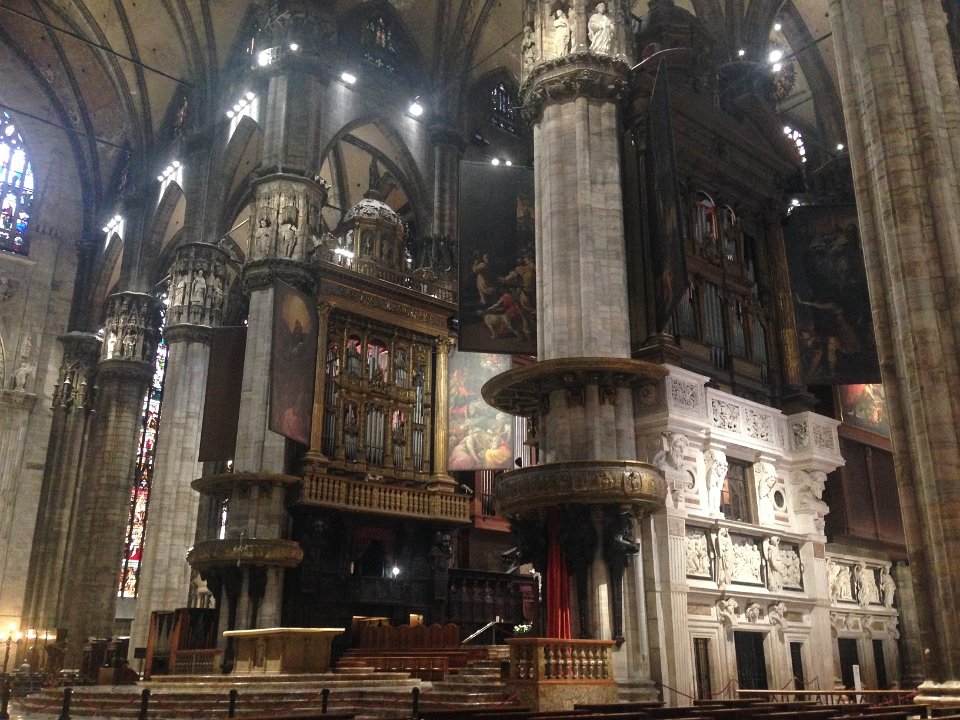
Duomo di Milano
One can imagine the saints outside standing in those exterior hotel elevators, going up and down along the their tall alcoves.
Inside the elevators are large and communal and have reached the ceiling, after traveling up along the columns.
The cathedral feels much bigger on the inside than it looks on the outside.
From the outside the building looks like a basilica, but inside the cross-shaped floorplan is clear.
The altar is almost in the center of the cross.
Unfortunately, the artificial lighting prevents us from seeing effects of the light as intended by the design.
When you enter and the inside feels much bigger than the outside, it’s like you’ve entered a place that transcends materiality. You’ve crossed a threshold and entered another world. It’s hard to even recall the small, almost symbolic, building you had seen outside. Here, inside is actual reality. Here you find the truth. The world outside is just theater, symbol, a decorative exterior.
If our VR cathedral has an exterior, maybe it should be like one of those maquettes you often see in or next to churches.
One is continuously counting in a cathedral. Because the numbers have meanings. Three is the trinity, four the evangelists, seven creation, twelve the apostles.
Maybe we should point out the numbers dynamically in our Cathedral.
A saint's body on display is fenced in so you can’t get close.
Play with inaccessibility and desire, unfulfilled.
The art strives for harmony with nature, not contrast.
Small cross floating in space slightly in front of altar.

Elevators along columns.

Large floor ornaments make you feel small.

Very intimidating to confess through this.

To suddenly see a body, lit differently, is startling.

The shrine can be seen and is alluringly lit. But inaccessible.

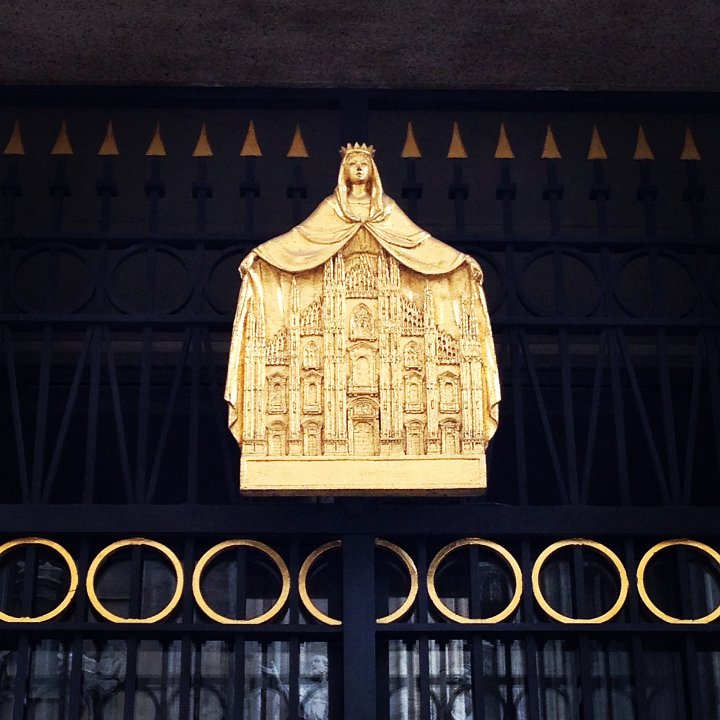
Pinacoteca di Brera
There are two realities. Earth and heaven.

Earth is familiar. And symbolically refers to heaven, longs for heaven, looks up to heaven. In heaven rational representation disappears. Heaven is absurd, not physical.
On the floor there's gravity. In heaven everything floats, materials lose their properties. Become ideas?

Despite the fact that the viewer inhabits material reality, it is still represented on the painting.
Material reality contains symbols, meaning. Immaterial reality makes no sense, is incomprehensible.
Desire to be immersed in historical scenes. To see your own body as part of the scene.
The ground is realistic. Heaven is crazy, spectacular.
There's no time or space in heaven.
Some figures on earth are larger than others.
Nothing happens in Crivelli's work. There's no spectacle, no action, no blood. Everything is a symbol. No landscape. Very little space. Just objects, things from planet earth.
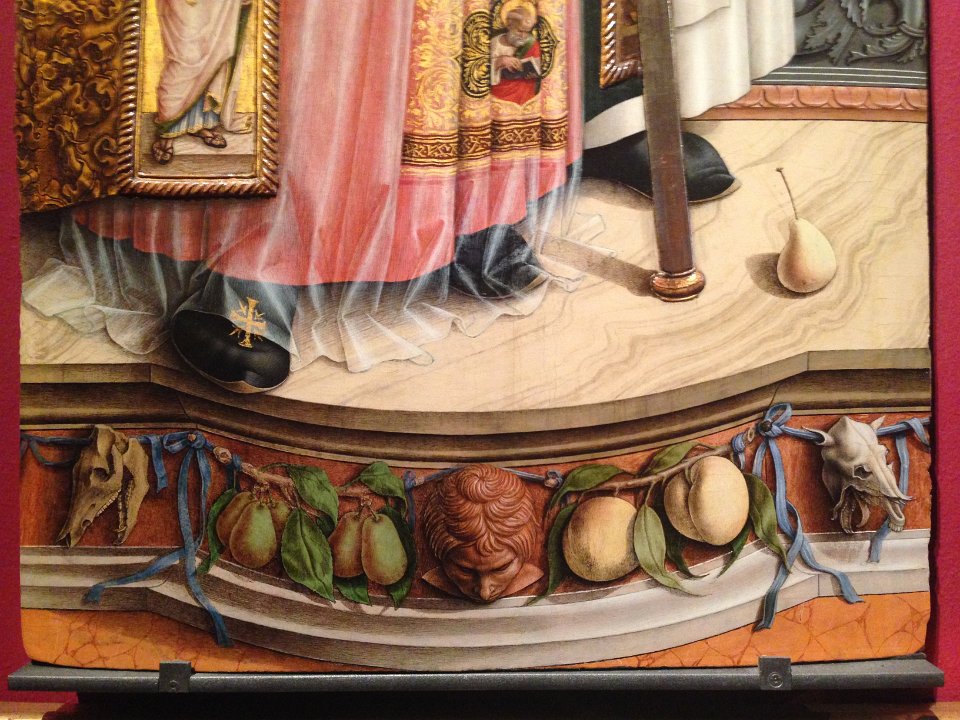
Crivelli makes me intensely happy
Holding the maquette which is the exterior of the cathedral.

Light coming out of the door of the cathedral exterior.
Cathedral resting on books.

A symmetrical composition is like an embrace. Body in the middle, arms open.

Are they sitting on an altar?

God's cape is a cherub emitter. It generates streams of cherubs continuously.
Jesus is blond.

A shiny mountain of cherubs.

When you paint on gold, you better make it count. You don't just paint anything on gold.
Earth is the realm of symbols. Heaven is the realm of truth.
When the care taken by the artist is clear, the spectator feels respected. When scrutiny is rewarded, both visually and conceptually.
A Crivelli is like an entire cathedral on one panel.
Just put cherubs everywhere. You can never have enough cherubs. Generate them. They sanctify the space.

Angels drop flowers.

Some angels are clear, others vague.

The circle represents movement, the square stability.
Basilica di Sant'Ambrogio
Saint Ambrose is the patron saint of Milan. So naturally we had to visit the church where his skeleton is still being displayed as a relic.
The dressed up skeleton of the former bishop lies directly under under the altar.

Sober walls but wild ceilings.
In the air everything floats and all is music.
Sound, music coming out of a side chapel.

Altar is slightly behind center, as if to keep the sacred center of the crossing open.

On the middle of the cross of the cathedral, you rise up. It's a spiritual elevator.

In a random church that we fled into to cool off from the heat outside small statues were presented very nicely, giving us ideas for displaying the dioramas in our own virtual cathedral.


Two dioramas. One hidden behind glass, the other strikingly present.

Glass intriguingly half hides the diorama inside, rendering it more mysterious.

The light comes from the Oculus in the dome of a side chapel.

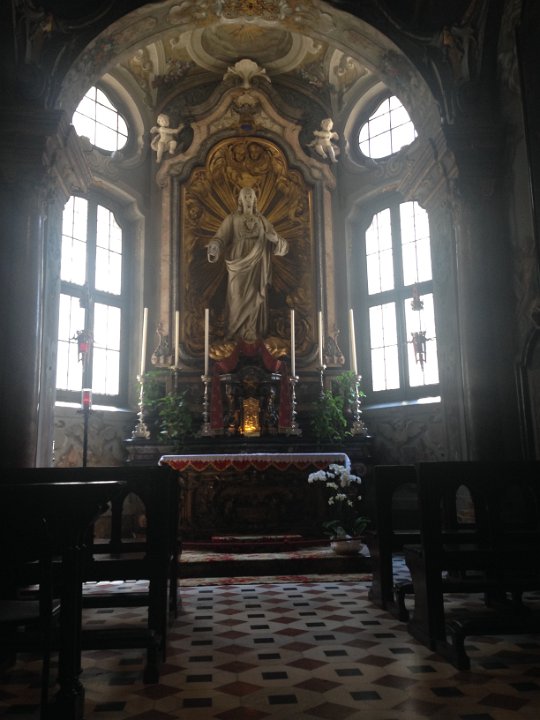
Genova
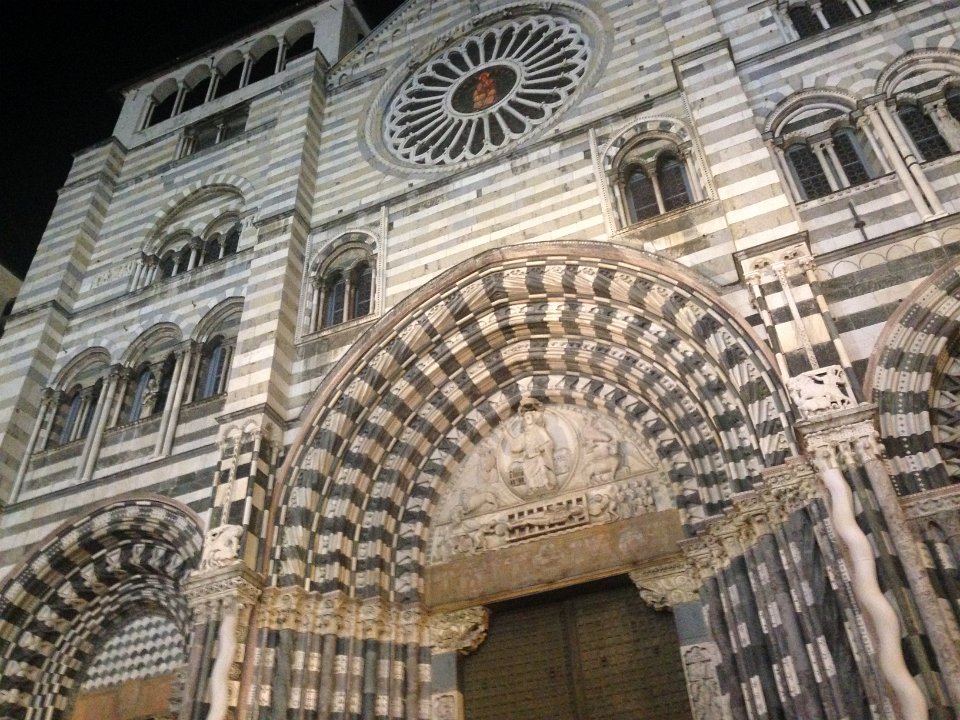
In the Chiesa del Gesù e dei Santi Ambrogio e Andrea in Genova, there's a wooden trapdoor under second row of chairs. Perhaps used for all sorts of baroque theatrical effects?

John the Baptist is the patron saint of Genoa. We were there on the feast of his nativity, to witness the spectacular procession leaving the cathedral on its way to the sea. We remained in the church while a service of alternating praying and choir singing seemed to provide the energy for the faithful to reach the ocean in the sweltering heat.
It was a great honor to attend the ritual.
The whole thing was rather casual. Choir singers would take of there robes in between songs and sit on the floor.
People would walk in and out. And all the time the service continued.
The casual behavior somehow makes the effect of the ritual stronger.
The choir singing sanctifies the light coming through the window.

When you're among Christians, you know people will be nice to you.
The church is activated by the activities of the people in it. Even the casual things they do, not just the ritual. Human activity becomes a moving spectacle.
A service could just be continuous. People walk in walk out. The building functions.
It's essential that the decoration is excessive. When there's too little, it looks ostentatious. It has to be more than imaginable.
Sailors leaving for the harbor carrying the relics of Saint John the Baptist on their shoulders. Video here.
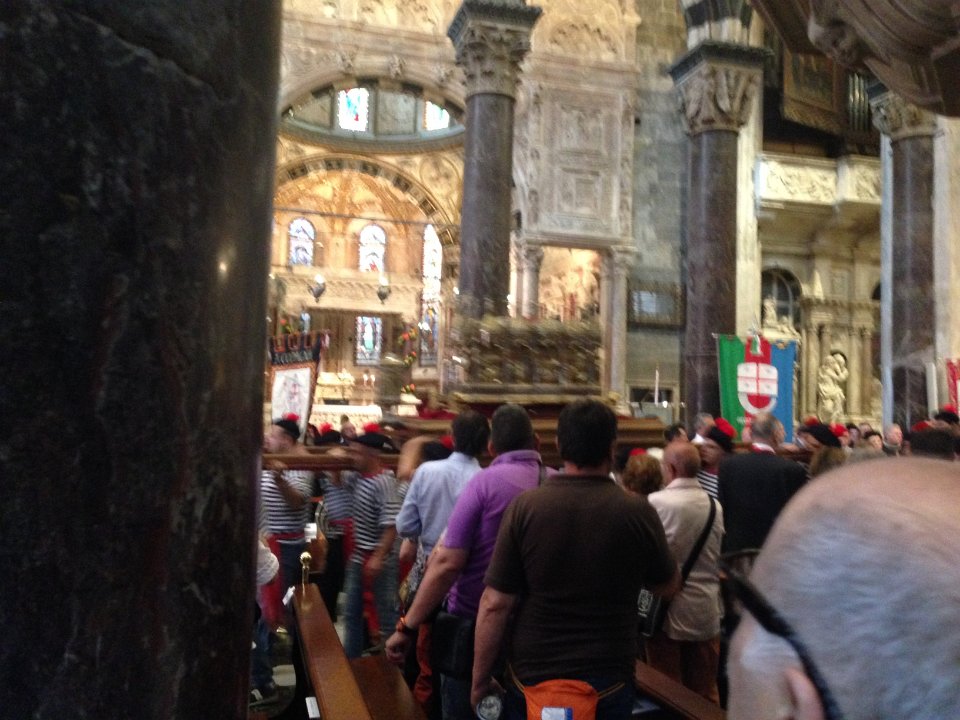
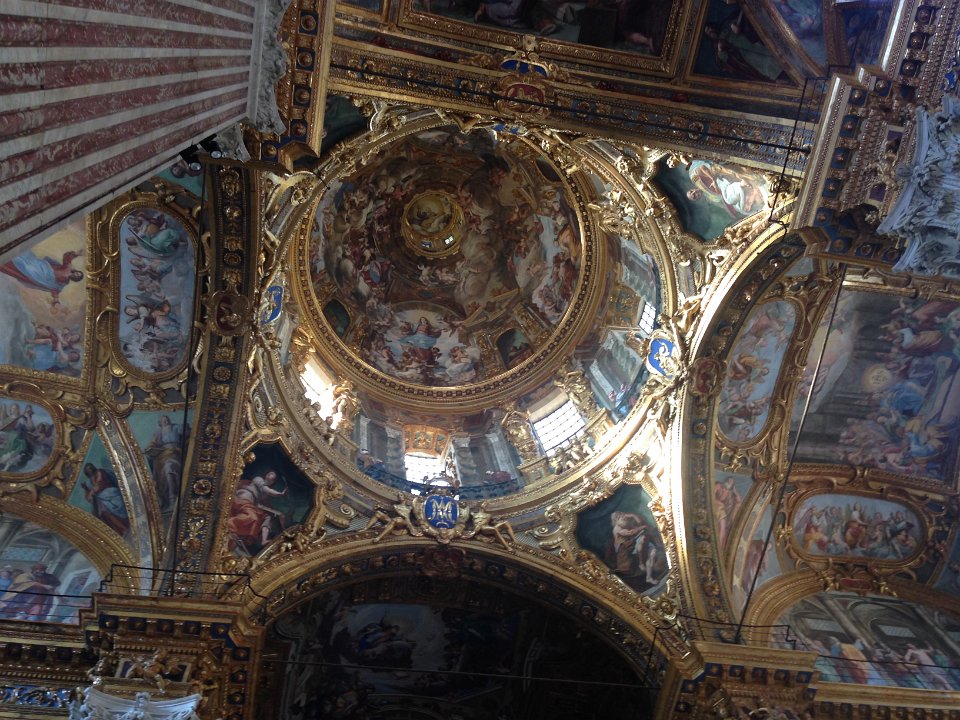
The old city of Genova is filled with churches.
Though they may sometimes be hard to spot from the outside.
The tall buildings and narrow streets don't offer much opportunity to attract the eye and prepare the visitor.
But once inside one experiences a sensation of space and light and wealth that contrasts profoundly with the rustic atmosphere outside.
Most churches we visited were baroque basilicas, typically with very ornate ceilings and rather sober floors, confirming the theme of earth below and heaven above that we had been noticing everywhere on this trip.

Santa Maria de la Vigne
surprised us with its combination of grandeur and casualness.
Somebody sits at a table using a tablet.
The church offers room for mundane activities. For people who just like being in churches, not only to pray.
Plain floors, gold ceilings.

Books to borrow and read.

Chairs for children.

A diorama of a mother and child surrounded by boys and girls baby souvenirs.

Babies holding words.

Words from heaven.


Eight is the number of Christ because an octagon is the intermediary between square and circle.
Cram it so full of things that no questions remain.
In a basilica, the choir is flanked by two chapels, mirroring the three doors in the facade that refer to the trinity.
San Siro
You walk in from the narrow streets into a wide open space of the basilica. From the dilapidated walls outside into the marble and gold inside. The churches are tucked away in city blocks. Somehow the grand facades are hardly noticeable. Until you step inside.
Double columns

Again, all the spectacle is on the ceiling.
The ceiling is just a little higher than seems possible.
What if the trompe-l'oeil paintings on the ceiling were real? And the church extends further, has an open roof, many people, some floating on clouds.

Separate chapel for baptisms.

Cute appropriately sentimental artwork in the baptistry.

Auriea forgot her bag in San Filippo Neri so we went back. The priest returned it, kneeling each time he crossed the altar. When exiting she dropped her phone and the glass shattered.
Basilica della Santissima Annunziata del Vastato
Hexagon tiles

Zigzag

I would feel uncomfortable performing the little Christian ritual gestures because I don't believe. But if I truly don't believe, why do I feel uncomfortable? I see it as a sign of respect towards believers but they can't know if I do or don't.
Chiesa di Santa Maria Maddalena
Churches are places of discovery partially because they are organized with repeating patterns.
Through the trompe-l'oeil window, you see the outside as it was imagined when the church was built. Now it has become a window into the past, into an imagined environment.

Deer drinking from a fountain filled by the sun of Christ. Also a golden door, to His body and blood.

In a silent church every move echoes like thunder.
San Matteo
It's lovely to see a group of statues in the dark, badly lit. Feels more real.

Panorama of San Matteo. Drag to look around.
Huge cherubs holding up the cupola.
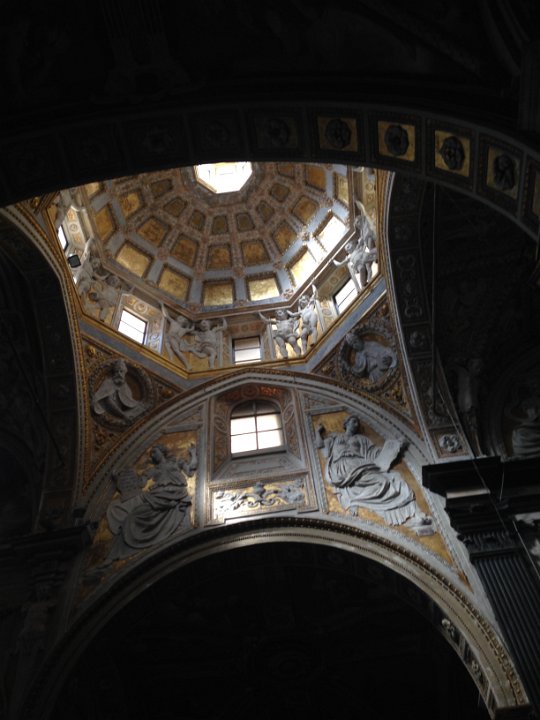
Another holy house. Third one today.

Pray and pay: coin slot in top of kneeling chair.

Works of mercy (for the Extraordinary Jubilee of Mercy this year, I presume).

Words float in the air and fornicate, producing little words. Echo.
Apply to cherubs and other emitted elements.
Art needs to be mysterious, incomprehensible.
Beauty must always be the goal.
More images, videos, panoramas and 3D scans here.
Wonderful Annunciation fresco in the cloister of Santa Maria di Castello in Genova, shown to us by a very friendly guide.
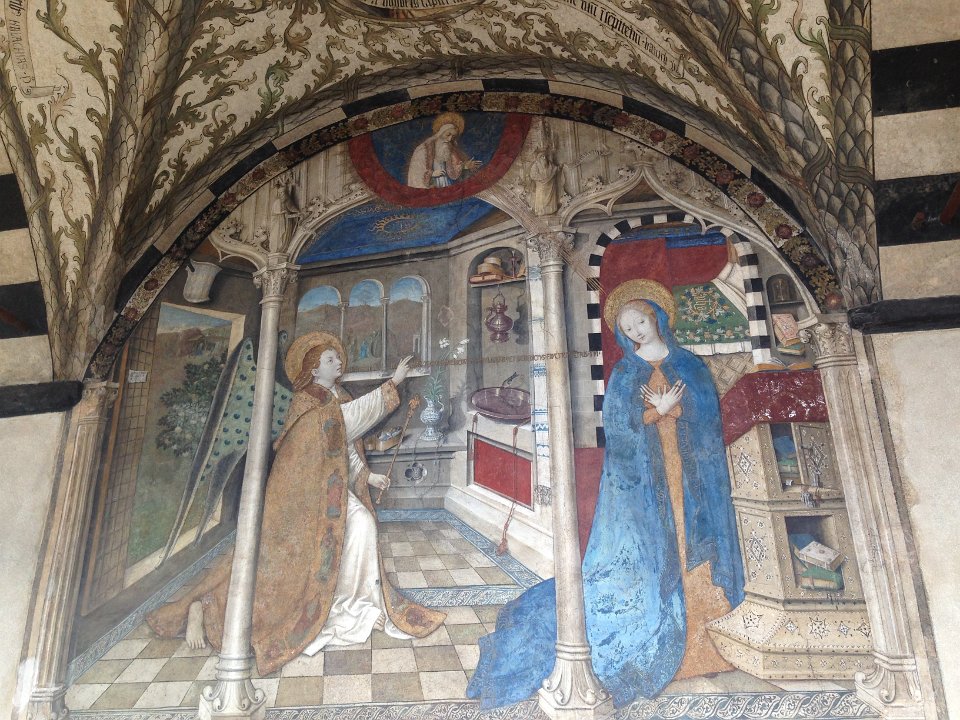
We scanned Canova's beautiful Penitent Magdalene statue in Palazzo Bianco in Genova.